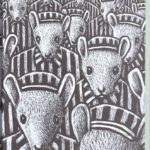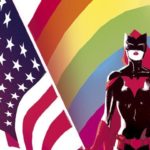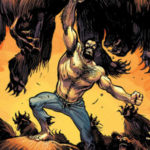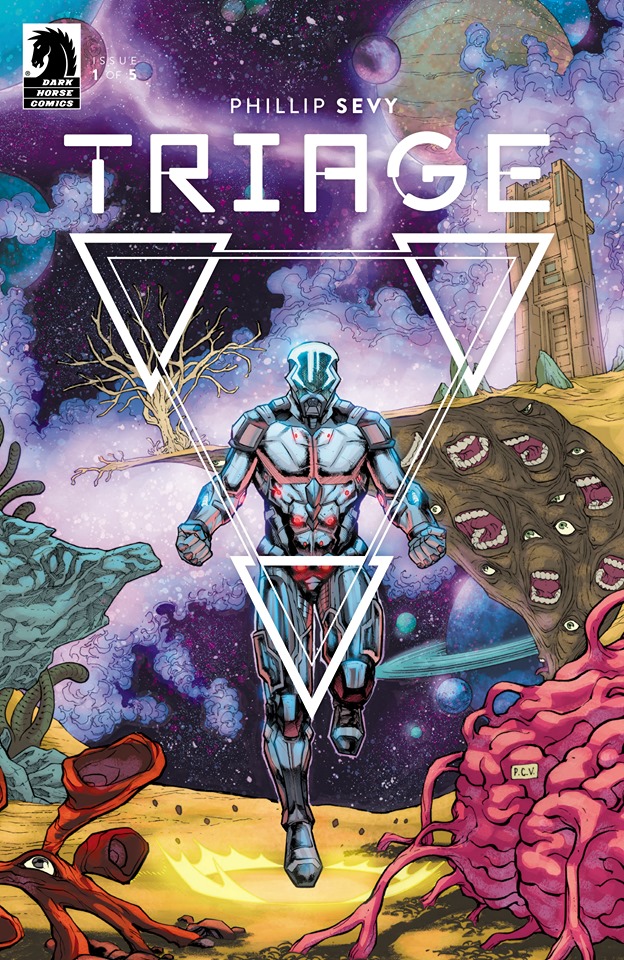
Phillip Sevy has worn a lot of hats throughout his life and career. This Wednesday, he dons another. That of Writer and Artist of a creator owned comic.
TRIAGE, from Dark Horse Comics, tells the story of Evelyn Pierce, a labor and delivery nurse living a relatively normal life. That is, until she is drawn into a multiversal conflict by her other selves, all of whom live different lives across worlds. One is a psychedelic superhero, another a warrior in a post apocalyptic wasteland. But they must all come together to solve the mystery of themselves and defeat a robotic, dimension hopping assassin.
Sevy was kind enough to sit down with Rogues Portal to discuss the series, its themes, and his life before the series’ debut on shelves this Wednesday.

ROGUES PORTAL: So, first off, the debut issue is amazing and so passionate, like an instantly realized universe (or multiverse, rather). How long was Triage in development?
PHILLIP SEVY: Shockingly, not as long as you might think. Last year (2018), four days before SDCC, I decided to come up with one more pitch (I had two I was walking around with). I had three character designs and a rough, rambling paragraph of an idea. I had a meeting with my Dark Horse editor (Megan Walker) to talk about post-Tomb Raider plans and she asked to see any pitches I had. I showed her Triage first and she liked it a lot. She asked me to write it down and send it to her. One year prior to the release date of issue one, it got approved!
RP: Did you start with any character concepts? Or did you just have a germ of the narrative idea first and flesh out from there?
PS: A little bit of both? I had wanted to do a sci-fi book, a post-apocalypse book, and a superhero book. I came up with a narrative that allowed me to mash all those genres together. From there, I had to make sure the designs worked for these characters in my head. Some like Evie came together quick. Marco didn’t take too long. Orbit I had about 30 variations until I found what I liked. The Hunter had one solid look initially that I completely scrapped and it took a handful more variations to find the final look.

RP: The themes of escapism and personal autonomy are pretty apparent even in the preview pages. Do you think Triage maybe started to look like a gateway out of your career in finance?
PS: I had actually left finance behind about eight years prior to getting Triage approved. But themes of identity crisis when arriving at the goals you had set only to realize you were miserable and not knowing what to do next all came from my experience of working in finance and realizing I hated it and needed to do something different. The second key to the narrative was a recent transition out of a high-demand, fundamental religion that I’d been a devoted member my entire 30+ years of living. That left me in a place of no self-identity and having to reconstruct my narrative while around friends and family members who only knew me as who I was. Those two dilemmas and experiences informed a lot of the problems and ideas at the center of Triage.
RP: What do you think was your EUREKA moment when it came to pursuing comics full time?
PS: There are probably lots of instances that I could point to, but going back to one of the earliest ones in my adult life was the decision to make a webcomic. From the time I was nine years old, I had wanted to draw comics and made that my life’s goal (as much as a nine-year-old can be goal-oriented). I started showing my portfolio at 15 at SDCC and did so for a few years. Life and other things got in the way and took me away from making comics (a large part of that being fear of failure and rejection). I got a degree in Corporate Finance and worked for Goldman Sachs for a few years.
It was miserable and I hated it, so much so that I ended up quitting and going to Art School—ha! But, while in the middle of my time in a cubicle, I was still writing stories. I had stories piling up that I wanted people to see. I seriously looked into moving to LA to try to get into screenwriting, but a lot of other factors (including a tanked economy in 2008) prevented that. Around that time, I had discovered Warren Ellis and Paul Duffield’s FreakAngels webcomic. Naively I thought, “I could do that.” Around the same time, I had a good friend reach out to me and ask. “Why don’t you just do a webcomic?” So I took stories I had that no one was reading and made them into a webcomic. I worked on it while I was at corporate for over a year and a half. I updated five pages a week until the story was done. It ended up being a 330+ page (terrible) epic. It got me back into making comics, going to conventions, and led me to art school to pursue comics. Flash forward years later, and here I am!
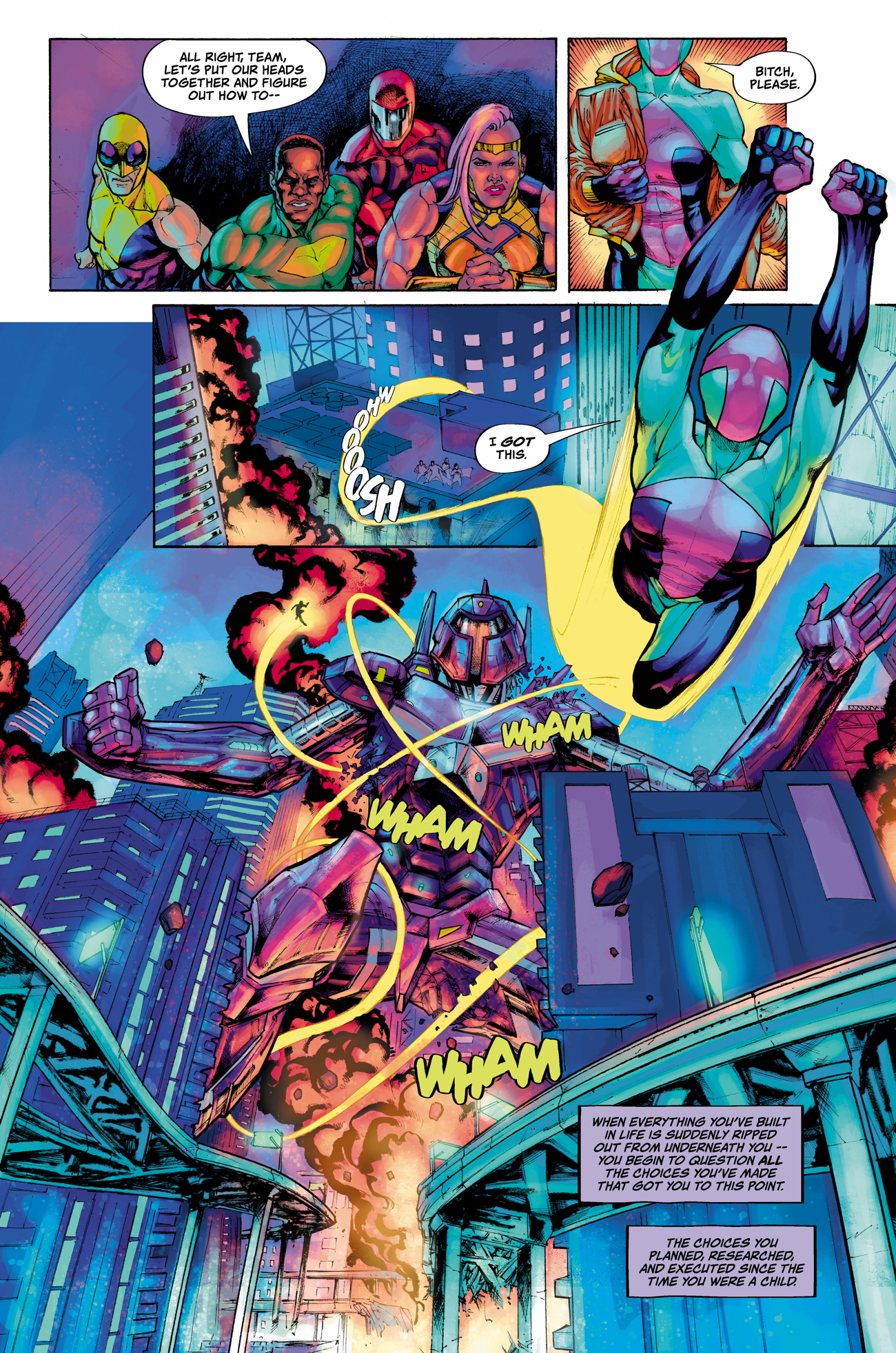
RP: Do you think that also was a factor in your turning away from fundamentalism?
PS: The biggest factor in me leaving behind the religion I grew up in was just being exposed to different people. I grew up in a fairly closed system—only around people like me. As I’ve grown up and gotten to know more and more different types of people, it’s helped shatter deeply entrenched ideas/dogmas that were rooted one way or the other in racism, sexism, homophobia, etc. It helped me see the world in a less myopic, me-centered way and helped me understand how I belonged to an organization that was hurting lots of different people and groups. It got to the point where I could no longer reconcile the reality of the world around me with the ideas I had been taught all my life. So I had to break away and be my own person on my own terms.
RP: We think readers are really going to respond to how personal this debut feels, even amid all the multiversal theatrics. How important to you was it to make this feel personal against such a large scale backdrop?
PS: For any project that I’m writing (especially one where I’m writing and drawing it), I have to find and have a deeply personal connection to the story. I have a two-level requirement for books that I pitch and create—there has to be something that gets me visually excited about the series and something that I can connect to in a very deep, emotional way.
The second is what keeps me motivated, committed, and excited day in and day out for however long it takes me to finish the project. It’s what keeps me thinking about the story and characters and problems and ideas. It’s what keeps me emotionally rooted in the story. And I hope that if I’m emotionally connected to a story that I spend endless hours inside that readers will find that connection too.

RP: Talk about your process as both the writer and artist of this series. Do you start with a full script? Rough backgrounds or layouts maybe? We’re endlessly fascinated by (and immensely jealous of) people who can do both.
PS: My process starts off fairly standard. I worked out a fairly detailed outline then broke it down in full scripts. I think my future scripts will be a bit looser, but I hadn’t worked with my editor as a writer before, so I wanted my scripts to be really complete so she could see that I (hopefully) knew what I was doing. From there, I do thumbs/layouts for the whole series. Then I try and pencil and ink a page at a time.
Once the line work is all done, I’ll color the issues at once. I think the difference comes as I’m working on each step. My mind is always visualizing forward and backward along the production steps. I’ll rewrite scenes and dialogue the whole time while also changing art up to the end. It’s a circular but linear method of creation, if that makes any sense. I work best with some structure and order, but having the ability to constantly refine the work up and down the production line is what sets the workflow as a Cartoonist apart from just an artist.
RP: How important is action to you as a creative? This debut has its share for sure, as did your very fun Tomb Raider run, but are you a “set piece” oriented writer? Or does that stuff just end up being the icing on the narrative cake for you?
PS: I love a good balance of character and action—but if you’re working on a comic, there better be something VISUAL happening in the series. People talking in a room can be brilliant and amazing (see: the opening scene of The Social Network), but DO NOT DO THAT in comics. That is not visual. Have objects moving. Utilize the aspects of this medium that it does well. Comics can be vehicles for movies, TV, novels, video games—whatever—but my favorite comics are pure COMICS. Stories designed for this medium and only this medium. Utilizing the aspects of the medium in order to create a wholly specific and authentic work.
RP: Where do you see Triage going in the future? Do you have more stories in these world(s) in mind?
PS: I worked really hard to craft a satisfying story in the five issues we have. I want the audience to feel closure when they get to the climax and resolution. I felt it would be a disservice to readers if we ended on a cliffhanger we couldn’t ever answer if sales didn’t warrant it. However, if we sell a million copies, there are vast areas of this world that I’d love to explore!
RP: Finally, what do you hope readers really get from this series?
PS: Outside of telling the best story that I could, my goal with Triage was to tell a story that made you feel the excitement of reading a comic for the first time. I came to comics in the early ’90s, and those books were so incredibly crazy and exciting. I was particularly an X-Men reader, and the X-Men books of the ’90s were incredible. You had time travel, multiple futures, techno-organic viruses, clones, legacy viruses, etc. Every issue was exploding with ideas and imagination.
I wanted to tell a story that was so COMIC that you couldn’t be mistaken for reading anything else. Something that pushed the limits of story and imagination infused with soap opera and exciting visuals as much as I could fit into five issues. Something that had the energy and excitement of the comics you read when you were younger that trapped your imagination. Hopefully, Triage does that!
TRIAGE hits shelves this WEDNESDAY.

